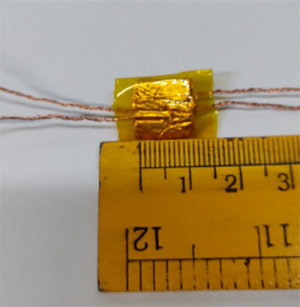FOR IMMEDIATE RELEASE
“Piezo/Triboelectric Nanogenerator from Lithium-Modified Zinc Titanium Oxide Nanofibers to Monitor Contact in Sports”
ACS Applied Nano Materials

If you watched the most recent Super Bowl, you know the importance of a referee’s call on the outcome of a game. Slow-motion replays and close-watching eyes help, but a new sensor technology could someday serve as an even more reliable tool for officials. Researchers reporting in ACS Applied Nano Materials have developed a self-powered, hybrid nanogenerator sensor that could help make more accurate calls and allow boxers and cricket players to practice more efficiently.
As sensors become less complicated and more ubiquitous, their applications have stretched into the world of sports, where they can offer detailed analyses to referees, coaches and players. But these sensors need to be small, self-powered and relatively cheap to be feasible. Two technologies well suited for this are triboelectric nanogenerators (TENGs) and piezoelectric nanogenerators (PENGs). Both work by converting mechanical energy into electric energy, albeit in different ways. When combined into one hybrid nanogenerator, their individual shortcomings can be mitigated, but these devices have so far failed to find many practical applications. So, Nishat Kumar Das, Om Priya Nanda and Sushmee Badhulika from the Indian Institute of Technology wanted to create a sensor powered by a hybrid nanogenerator that could be used to monitor real-life performance in boxing and cricket.
To manufacture their sensor, the researchers created nanofibers from lithium-modified zinc titanium oxide. These were layered with copper, a special kind of tape and other films with certain characteristics to create either a TENG or PENG. The PENG was mounted to a cricket bat and the stumps of a wicket — used similarly to the bases in American baseball. If the ball contacted the sensors, it produced a voltage that could be used to determine a call. When used during practice, it provided data corresponding to the accuracy and power of the swing, with a response time of around 0.02 seconds. Then, they combined this PENG with a TENG to make a hybrid nanogenerator, four of which were then mounted to different parts of a punching bag. The devices distinguished between the six different types of punches used in boxing, as well as the speed of each, giving a player and their coach information about their style. The researchers say that this work could pave a way for exploring other applications for nanogenerators in sports.
The authors acknowledge funding from the Defense Research Development Organization (DRDO).
###
The American Chemical Society (ACS) is a nonprofit organization chartered by the U.S. Congress. ACS’ mission is to advance the broader chemistry enterprise and its practitioners for the benefit of Earth and all its people. The Society is a global leader in promoting excellence in science education and providing access to chemistry-related information and research through its multiple research solutions, peer-reviewed journals, scientific conferences, eBooks and weekly news periodical Chemical & Engineering News. ACS journals are among the most cited, most trusted and most read within the scientific literature; however, ACS itself does not conduct chemical research. As a leader in scientific information solutions, its CAS division partners with global innovators to accelerate breakthroughs by curating, connecting and analyzing the world’s scientific knowledge. ACS’ main offices are in Washington, D.C., and Columbus, Ohio.
To automatically receive press releases from the American Chemical Society, contact newsroom@acs.org.
Note: ACS does not conduct research, but publishes and publicizes peer-reviewed scientific studies.








